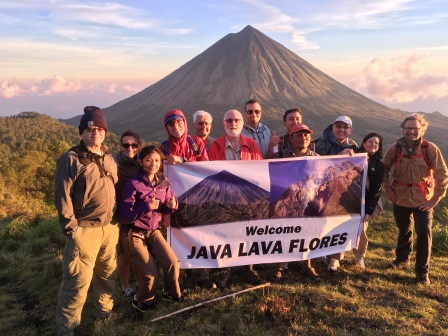This section provides advice about climbing mountains in general and volcanoes in particular. If dangers are encountered, follow the advice of the leader/guides and use lots of common sense.
- The ‘Wise Old Wolf’ leadership technique: in dangerous situations, especially ‘whiteouts’, the group should stay together. An experienced climber should take the lead with weaker, slower climbers immediately behind (the she wolves and their cubs) and finally the fit, stronger climbers in the rear.
- Technical climbing: Java Lava climbs do not require technical climbing skills. Reaching the ‘true summit’ of some mountains can be difficult and even dangerous; technical climbing is beyond the scope of Java Lava.
- Never leave the path: Tracks up volcanoes are usually along ridges, often narrow and with deep ravines below. If you fall off a ridge, it may be extremely difficult to recover you or your body.
- Never take short-cuts: This is the surest way of becoming lost especially on the descent.
- Eruptive status of volcanoes: The Indonesian Geological Agency monitors most potentially active volcanoes. If an eruptive stage of 2 or more has been declared, stay off the volcano.
- Be alert for eruptions: Some volcanoes erupt regularly, e.g., Semeru, about every 20 minutes or so depending on its mood, or almost continuously, e.g., Dukono, northern Halmahera.
- Stay away from the crater rim: If you fall in, don’t expect that your body will ever be recovered. If the crater is active, you will receive a fitting cremation.
- Always start at a slow and steady pace until finding your own rhythm. Volcanoes are steep, usually 30+ degrees on the upper slopes. The ascent is tough work requiring sheer will power to overcome exhaustion. Don’t try to keep up with the fast, fit ‘mountain goats’ in your group.
- Altitude sickness: above about 3,200 m some individuals may begin to feel the effects of rarefied oxygen; headaches and sleeping difficulties are the first symptoms. Acetylsalicylic acid (Aspirin, Paracetamol, etc.) is useful. Consult the leader if you have concerns during a climb. As a ‘rule of thumb’, if you experience altitude sickness you should descend 500 ms to recuperate then try the ascent again later.
- The descent: This can be as challenging than the ascent. A different set of muscles come into play and can be painful if you are unfit. Voltaren, gel and tablets, can provide some relief.
- Forest fires: During extreme dry conditions, the upper slopes of mountains can be tinder dry. Always try to stay upwind of fires. It is always safer to trek through recently burnt areas, even if still smouldering, than dense undergrowth that may be subject to fires.
- Aborting a climb: There is no shame in camping/descending prematurely if you are unwell or find the going too tough. In fact, this is a wise decision for your own safety and that of the group as a whole. Consult the leader/guides before separating from the group; ensure that you are accompanied by the porter carrying your porter pack for the camp/descent; and, that you have adequate water and food. Never descend alone.


